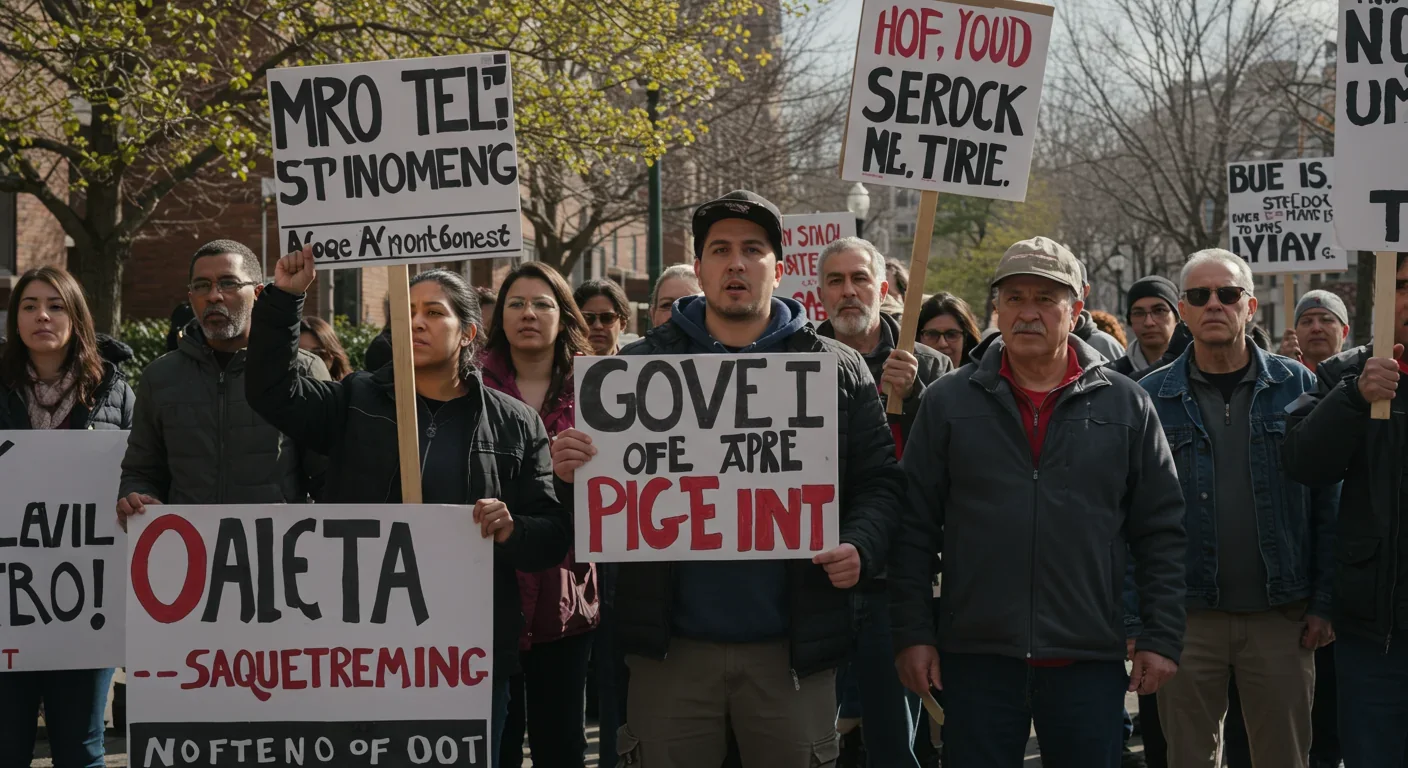When Reality Becomes Partisan: The Death of Shared Truth

TL;DR: Behind every AI system lies an invisible workforce of ghost workers—people in Kenya, Venezuela, and the Philippines labeling data and moderating content for as little as $1 per hour. These workers face exploitation, psychological trauma, and zero labor protections while trillion-dollar tech companies profit from their hidden labor.
When you ask ChatGPT a question or let your Tesla navigate traffic, you're benefiting from what seems like pure machine intelligence. But behind these "automated" systems lies a vast, invisible workforce of humans performing tedious, often traumatic labor for pennies—work so obscured that it's called ghost work.
The term is fitting. These workers haunt the edges of the AI industry, essential yet unseen, labeling millions of images, moderating disturbing content, and teaching algorithms to recognize everything from stop signs to hate speech. They're the reason your AI seems smart, yet their contributions are deliberately hidden behind the illusion of pure automation.
This isn't a side story about AI development. It's the story—one that exposes how the multi-billion dollar AI revolution depends on exploiting human labor in ways that would shock most users of these technologies.

Artificial intelligence has a marketing problem that's also a moral crisis. Companies sell their products as autonomous, self-learning systems that improve through machine learning alone. The reality is starkly different.
Every major AI system—from Google's Gemini to OpenAI's GPT models—requires enormous quantities of labeled data. Algorithms can't learn what a cat is until thousands of images have been tagged "cat" by humans. Self-driving cars need human annotators to draw boxes around pedestrians, cyclists, and vehicles in millions of video frames. Content moderation AI must be trained on examples that humans first identified as hate speech, violence, or misinformation.
This isn't a temporary phase. As AI systems become more sophisticated, they require more nuanced, context-dependent data that only humans can provide. The ghost work industry isn't shrinking—it's exploding.
The faces behind your AI aren't who you'd expect. They're not well-paid tech workers in Silicon Valley. They're Kenyan mothers labeling violent content for Facebook, Venezuelan students annotating medical images for under $2 an hour, and Turkish workers moderating TikTok videos in cramped offices with minimal mental health support.
The demographics reveal the system's exploitation. Workers are concentrated in countries with weak labor protections and desperate economic situations: Kenya, the Philippines, India, Venezuela, and increasingly across sub-Saharan Africa. Many have university degrees but face unemployment rates that make even poverty wages attractive.
Amazon Mechanical Turk, launched in 2005, pioneered this model. The platform's name is revealing—it references an 18th-century "chess-playing automaton" that appeared mechanical but actually concealed a human chess master inside. MTurk treats human intelligence as an API, an on-demand resource that businesses can call upon without ever acknowledging the humans providing it.
Amazon Mechanical Turk's name reveals the deception at the heart of ghost work: what appears to be machine intelligence is actually concealed human labor, exploited and made invisible.
By 2018, MTurk had approximately 100,000 available workers at any given time, though only about 2,000 were actively working. The platform grew from 100,000 workers in 2007 to over 500,000 registered workers by 2011. Today, major companies like Scale AI—valued at $14 billion after a massive Meta investment—coordinate hundreds of thousands more workers globally through crowdsourcing platforms.
These aren't employees. They're classified as independent contractors, a designation that shields companies from providing minimum wage, overtime, health insurance, or workers' compensation.

The pay is staggering in its inadequacy. Studies consistently show that ghost workers earn between $1 and $2 per hour, far below minimum wage in their own countries, let alone in the U.S. where the companies employing them are based.
A comprehensive study of 3.8 million tasks on Amazon Mechanical Turk found that workers earned a median hourly wage of about $2, with only 4% earning more than $7.25 per hour. In Venezuela, where economic collapse has made any income valuable, data labelers earn between 90 cents and $2 per hour. The same work in the United States pays $10 to $25 per hour—but few U.S. workers will accept such rates, so the work flows to desperate international markets.
The actual earnings are even lower than these figures suggest because workers aren't paid for essential unpaid labor: searching for available tasks, competing with other workers for assignments, dealing with rejected work, or managing technical problems. On platforms like MTurk, workers must constantly refresh screens looking for high-value tasks that disappear in seconds.
Meanwhile, the companies extracting this labor are immensely profitable. Scale AI, which coordinates data labeling for companies like Meta, OpenAI (until recently), and the U.S. military, reached a $29 billion valuation in recent funding rounds. Amazon takes a minimum 20% commission on all Mechanical Turk tasks, extracting profit from both sides of already exploitative transactions.
The data annotation and labeling market is projected to reach $6.98 billion by 2029, with other forecasts suggesting it could grow to $8.2 billion by 2028. This explosive growth reflects AI's insatiable hunger for training data—and the expanding exploitation needed to feed it.
"We do this work at great cost to our health, our lives and our families… for less than $2 per hour."
— Kenyan data labelers, open letter to President Biden
If the wages are unconscionable, the working conditions are nightmarish. Content moderators—ghost workers who review flagged material to train AI systems—face some of the most traumatic work imaginable.
In May 2024, nearly 100 Kenyan data labelers wrote an open letter to U.S. President Joe Biden describing conditions they called "modern-day slavery." These workers spend more than eight hours daily reviewing graphic content: murders, suicides, child sexual abuse, bestiality, and extreme violence. The goal is to identify this material so AI systems can automatically detect and remove it. The human cost is devastating.

More than 140 Facebook moderators in Kenya have been diagnosed with severe post-traumatic stress disorder. Many report insomnia, panic attacks, depression, and an inability to form normal relationships. Yet these workers receive minimal mental health support—if any.
One former moderator for TikTok in Turkey described watching hundreds of horrific videos daily, with supervisors pressuring workers to meet quotas that made thoughtful review impossible. When workers complained about the psychological impact, they faced union-busting tactics and termination.
The companies employing these workers claim to provide wellness programs and counseling. But investigations consistently reveal that such support is inadequate, understaffed, or effectively inaccessible due to stigma and workload pressures. Workers who take mental health breaks risk losing their already precarious positions.
A BBC investigation found that moderators reviewing the most extreme content often receive just five to ten minutes of counseling per week—a shockingly inadequate response to daily trauma exposure that would violate ethical standards in any legitimate medical or therapeutic context.
More than 140 Facebook content moderators in Kenya have been diagnosed with severe PTSD after spending eight-hour shifts reviewing murders, child abuse, and extreme violence—for less than $2 per hour.
How do major tech companies maintain plausible deniability about these conditions? Through layers of subcontracting that distance them from the workers they depend on.
Companies like Meta, Google, and OpenAI rarely hire ghost workers directly. Instead, they contract with intermediary firms—companies like Scale AI, Appen, Sama (formerly Samasource), and Clickworker. These intermediaries, in turn, often subcontract to local firms in countries with cheap labor.
This arrangement creates what labor scholars call "fissured workplaces." When African content moderators sued Meta for the psychological harm they suffered, Meta argued it wasn't their employer—the local subcontractor was. When that subcontractor's conditions are exposed, Meta can claim ignorance and terminate the contract, only to begin another relationship with a different intermediary.
Scale AI's business model exemplifies this system. The company positions itself as a technology platform, not an employer. It connects businesses needing data annotation with distributed workers, extracting profit while avoiding responsibility for wages, conditions, or worker welfare. After Meta invested heavily in Scale, competitors like Google, OpenAI, and Microsoft reportedly ended their partnerships, not out of labor concerns, but due to competitive conflicts.
The intermediary model also enables geographic arbitrage. Data labeling that might cost $15 per hour in the U.S. becomes economically viable at $1.50 per hour in Kenya or Venezuela. Companies specifically target countries with high unemployment, educated workforces, and limited labor protections—conditions that maximize profit extraction while minimizing worker power.

Ghost work didn't emerge in a vacuum. It's part of the broader gig economy model that has reshaped labor across industries, from Uber drivers to food delivery workers.
The key innovation is legal: classifying workers as independent contractors rather than employees. This single designation allows companies to avoid minimum wage laws, overtime requirements, workplace safety regulations, unemployment insurance, and anti-discrimination protections. In the U.S. alone, misclassification saves employers an estimated 30% on labor costs by shifting taxes, insurance, and benefits onto workers.
But ghost work adds a digital layer that makes exploitation even more efficient. Algorithmic management assigns tasks, monitors performance, and determines pay without human oversight. Workers are rated by automated systems that can deactivate accounts for falling below quality thresholds, all without explanation or appeal.
Research on algorithmic wage discrimination shows that these systems often pay different workers different rates for identical work, with no transparency about why. Newer workers, or those from poorer countries, systematically receive lower pay. The algorithms optimize for the lowest possible labor costs, perpetually finding workers desperate enough to accept whatever is offered.
Workers report that the platforms feel less like employers and more like invisible overseers—omnipresent, punitive, and impossible to reason with. You can't negotiate with an algorithm. You can't explain why your work was high-quality despite being rejected. The system just deactivates you and moves on to the next desperate worker.
The existence of ghost work demolishes one of AI's central claims: that these systems represent genuine automation reducing human labor. The opposite is true. AI creates new forms of hidden human labor while presenting itself as eliminating it.
Consider how an "automated" content moderation system actually works. Human moderators first review millions of examples, labeling what should be removed. This labeled data trains an AI model. But the AI makes mistakes, requiring humans to review flagged content and correct errors. These corrections generate new training data, which updates the model. The cycle never ends because language, culture, and harmful content constantly evolve.
Rather than replacing human labor, AI amplifies it while making it invisible. When Facebook claims its AI detects 95% of hate speech automatically, what they mean is that underpaid workers in Kenya already identified and labeled the training examples, and other underpaid workers review the edge cases that confuse the algorithm.
"Our working conditions amount to modern day slavery."
— Open letter by nearly 100 data labellers from Kenya
The International Labour Organization calls this "the AI illusion"—presenting human labor as machine automation to justify lower prices, reduce accountability, and avoid the costs and regulations associated with employment.
This matters beyond labor rights. If we believe AI is genuinely autonomous, we attribute moral agency to machines rather than the humans building and controlling them. When an AI system generates biased outputs, we blame the algorithm rather than the workers who were given inadequate instructions, impossible timelines, and no stake in the outcome. The ghost work system doesn't just exploit workers—it obscures responsibility.
Despite the structural obstacles, ghost workers are organizing. The past few years have seen unprecedented activism among data workers worldwide.
Content moderators in Kenya have filed multiple lawsuits against Meta and its contractors, demanding compensation for psychological trauma and recognition as Meta employees. In Turkey, TikTok moderators formed a union to fight for better conditions, only to face aggressive union-busting tactics.

Worker advocacy organizations like the African Content Moderators Union and the global Fairwork Foundation are documenting conditions and pressuring platforms to adopt minimum standards. The Fairwork Foundation rates gig platforms on five principles: fair pay, fair conditions, fair contracts, fair management, and fair representation. Most ghost work platforms score near zero.
Some workers are building alternatives. FairCrowd, a worker-owned platform, aims to connect freelancers with businesses while ensuring living wages and democratic governance. But worker cooperatives struggle to compete with platforms optimized for exploitation.
The most powerful development may be content moderators uniting across borders to share strategies and coordinate demands. A 2025 summit brought together moderators from Kenya, the Philippines, India, and Latin America to build solidarity and develop common demands: direct employment by tech companies, mental health support, higher wages, and the right to organize.
These movements face enormous challenges. Ghost workers are geographically dispersed, legally isolated, and economically vulnerable. Companies can simply move work to countries with less activism. But the moral clarity of their demands—that trillion-dollar companies should pay living wages and not traumatize workers—is difficult to dismiss.
Governments are beginning to notice, though action lags far behind the problem. The European Union's AI Act includes provisions requiring transparency about data workers in AI supply chains, but enforcement mechanisms remain unclear. Some European countries have begun reclassifying gig workers as employees, which could extend to ghost workers.
In the United States, the National Labor Relations Board has taken tentative steps toward recognizing that algorithmic management can constitute employer control, potentially making workers employees rather than contractors. But tech industry lobbying has prevented broader legislation, and different states apply wildly different standards.
Brookings Institution researchers argue that addressing ghost work requires international cooperation because companies will always arbitrage toward the weakest regulations. They propose global minimum standards for data work, enforced through trade agreements that make access to wealthy markets contingent on fair labor practices in AI supply chains.
Kenya, which has become a hub for content moderation, is considering legislation specifically addressing tech platform labor. But reformers face intense pressure from companies threatening to move work elsewhere if conditions improve.
The fundamental challenge is that global labor markets allow companies to exploit regulatory gaps. A platform registered in Delaware, with servers in Ireland, coordinating workers in Kenya, and serving customers in Japan, can evade accountability at every level.
The ghost work crisis exposes a fundamental flaw in how we think about AI ethics. Most AI ethics frameworks focus on algorithmic fairness, transparency, and accountability—important issues, but ones that ignore the labor conditions that make AI possible.
Research organizations increasingly argue that ethical AI must include labor justice. An AI system trained on data labeled by exploited workers cannot be ethical, regardless of how unbiased its outputs are. The harm is baked into the production process.
This has implications for consumers and policymakers. When evaluating AI companies, we should ask: How are your data workers classified? What do they earn? What mental health support exists? Are they allowed to organize? Companies that refuse to answer, or hide behind layers of subcontracting, are almost certainly exploiting workers.
For major tech firms, addressing ghost work means confronting business models built on externalizing costs onto vulnerable workers. It requires acknowledging that AI isn't actually as automated or efficient as marketed—it's a labor-intensive industry that has found ways to hide and devalue that labor.
The AI revolution has produced remarkable capabilities. But it's been built through means that resemble 19th-century exploitation more than 21st-century innovation. Until we recognize and address the human cost behind machine learning, we're not advancing technology—we're just finding new ways to extract value from the powerless while calling it progress.
Change is possible, but it requires pressure at every level. Consumers can choose services from companies with transparent, ethical labor practices. Workers can organize despite the obstacles. Researchers can refuse to use datasets created through exploitation. Regulators can close loopholes that enable misclassification and wage theft.
Most importantly, we can reject the narrative that ghost work is inevitable or necessary. Paying fair wages would increase AI development costs, but these are trillion-dollar companies claiming to build the future. If their business models only work through exploitation, those models should fail.
The alternative platforms emerging—worker-owned cooperatives, fair trade data labeling services, companies that refuse to participate in the race to the bottom—prove that ethical AI labor is feasible. They just can't compete with companies willing to pay workers $1 per hour.
Ultimately, how we resolve the ghost work crisis will determine what kind of technological future we're building. Will AI's benefits be concentrated among a few corporations while its costs are distributed among millions of vulnerable workers? Or will we build systems that distribute both benefits and responsibilities fairly?
The workers who make AI possible deserve to be seen, valued, and compensated fairly. Anything less isn't innovation—it's exploitation wearing a silicon mask.

Curiosity rover detects mysterious methane spikes on Mars that vanish within hours, defying atmospheric models. Scientists debate whether the source is hidden microbial life or geological processes, while new research reveals UV-activated dust rapidly destroys the gas.

CMA is a selective cellular cleanup system that targets damaged proteins for degradation. As we age, CMA declines—leading to toxic protein accumulation and neurodegeneration. Scientists are developing therapies to restore CMA function and potentially prevent brain diseases.

Intercropping boosts farm yields by 20-50% by growing multiple crops together, using complementary resource use, nitrogen fixation, and pest suppression to build resilience against climate shocks while reducing costs.

Cryptomnesia—unconsciously reproducing ideas you've encountered before while believing them to be original—affects everyone from songwriters to academics. This article explores the neuroscience behind why our brains fail to flag recycled ideas and provides evidence-based strategies to protect your creative integrity.

Cuttlefish pass the marshmallow test by waiting up to 130 seconds for preferred food, demonstrating time perception and self-control with a radically different brain structure. This challenges assumptions about intelligence requiring vertebrate-type brains and suggests consciousness may be more widespread than previously thought.

Epistemic closure has fractured shared reality: algorithmic echo chambers and motivated reasoning trap us in separate information ecosystems where we can't agree on basic facts. This threatens democracy, public health coordination, and collective action on civilizational challenges. Solutions require platform accountability, media literacy, identity-bridging interventions, and cultural commitment to truth over tribalism.

Transformer architectures with self-attention mechanisms have completely replaced static word vectors like Word2Vec in NLP by generating contextual embeddings that adapt to word meaning based on surrounding context, enabling dramatic performance improvements across all language understanding tasks.